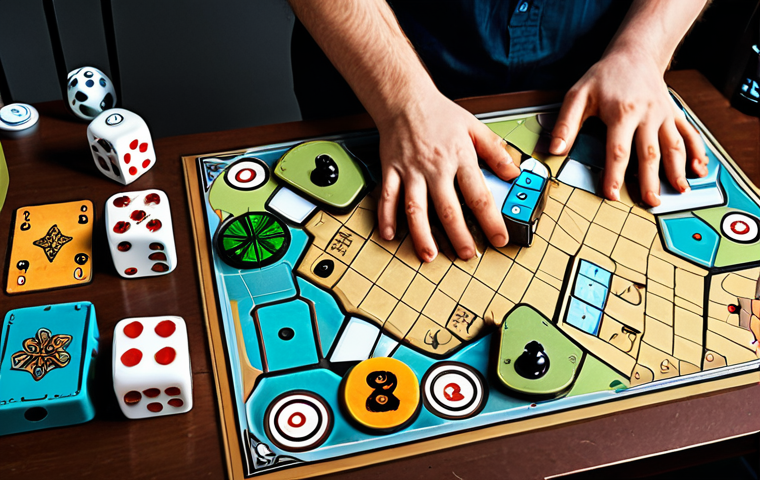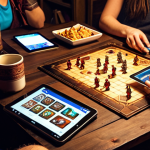Remember that electric buzz when you finally crack a challenging strategy game, or the collective gasp when someone pulls off an impossible move? For me, that’s the magic of tabletop gaming, a feeling that never gets old.
What truly struck me over the past few years is how much this hobby has exploded, moving far beyond dusty old sets in the cupboard. We’re in a golden age, with incredible innovations like legacy campaigns that evolve with every play, intensely thematic narratives, and even clever digital integrations that enhance the physical experience without replacing it.
Just think about the rise of crowdfunding platforms; they’ve allowed creators to bring incredibly ambitious projects to life, often reflecting niche interests and driving new trends we never anticipated.
I’ve personally backed a few, and the journey from concept to final product is just fascinating. This forum isn’t just about sharing what we’re currently playing; it’s about exploring these evolving landscapes, discussing future predictions – like how AI might streamline rulebook learning, or the growing emphasis on sustainable production – and connecting over our shared love for all things tabletop.
It’s a space where every game night story, every tough decision, and every triumphant victory finds its echo. Let’s dive deeper below.
The Shifting Sands of Game Mechanics: From Simple Rolls to Epic Systems

The landscape of board game mechanics has utterly transformed, and honestly, it’s nothing short of revolutionary. I remember when “game night” usually meant rolling dice, moving pieces, and hoping for the best, or maybe a fiercely competitive game of chess.
While those classics still hold a cherished spot, today’s games are weaving incredibly intricate webs of decisions, pushing the boundaries of what a physical game can achieve.
We’re talking about mechanics that truly simulate economic markets, political intrigue, or even the desperate struggle for survival in a post-apocalyptic world.
It’s not just about luck anymore; it’s about strategic depth that makes you feel genuinely clever, or spectacularly outwitted, depending on the game night!
This evolution speaks volumes about the creativity brewing in the design community, constantly exploring new ways for players to interact with the game world and each other.
The Rise of Player Agency and Meaningful Choices
One of the most striking developments I’ve personally witnessed is the emphasis on player agency. Gone are the days when you just moved your piece and drew a card, hoping for a good outcome.
Now, every decision feels heavy, impactful, and genuinely shapes the narrative or your path to victory. From the elegant simplicity of worker placement games where every spot is a calculated risk, to the complex decision trees in narrative-driven legacy games where your choices permanently alter the game world, players are no longer passive participants.
This focus on meaningful choices deeply immerses you, as if the game is truly reacting to your unique strategy. It’s what keeps me coming back, the feeling that *I* am crafting the story, not just reading it.
Innovative Mechanics Redefining Interaction
Beyond simple dice rolls and card draws, modern tabletop games are pioneers in mechanical innovation. Think about the “bag-building” mechanic where you strategically add and remove tokens from a bag, creating a customized pool for future draws – it’s a brilliant twist on deck-building.
Or the advent of “action selection” systems that force difficult trade-offs, often leaving you agonizing over what you *can’t* do. I recently played a game where resource management was tied directly to your physical placement on a modular board, and it completely changed my approach to planning.
These innovations aren’t just new for novelty’s sake; they genuinely enhance the strategic depth and replayability, ensuring that even after dozens of plays, you’re still discovering new synergies and optimal paths.
The Immersive Power of Narrative and Thematic Storytelling
For me, a game truly comes alive when its mechanics are intertwined with a compelling story. It’s not just about moving pawns; it’s about embodying a desperate survivor in a zombie apocalypse, or becoming a cunning merchant navigating treacherous trade routes.
The thematic depth in modern board games is astounding, often rivaling that of novels or films. This isn’t just window dressing; the theme often informs and elevates the gameplay, making every turn feel like a chapter in a grand adventure.
When I look across my game shelf, the games that I cherish most are the ones that have left me with vivid memories of daring escapes, heart-wrenching decisions, or triumphant victories, all steeped in a rich, believable world.
How Theme Drives Engagement and Replayability
A strong theme does more than just look pretty on the box; it fundamentally shapes how you engage with the game. When you’re playing a game with a truly immersive theme, your brain naturally starts to fill in the blanks, creating a richer experience than the sum of its parts.
For instance, in a cooperative horror game, the theme of dwindling sanity and creeping dread isn’t just described in the flavor text; it’s reinforced by mechanics that force difficult choices under pressure or by a dwindling deck of sanity cards.
This thematic cohesion makes every setback more dramatic and every victory more satisfying. It’s this deep emotional connection, forged through narrative, that ensures a game doesn’t just get played once and shelved, but rather becomes a recurring story in your life.
The Evolution of Narrative Structures in Games
The way stories are told in board games has also evolved dramatically. We’ve moved far beyond simple “choose your own adventure” elements. Legacy games, for example, allow narratives to permanently branch and evolve based on player decisions, leaving an indelible mark on the game components themselves.
Campaign games tell sprawling stories over multiple sessions, with characters gaining skills, discovering secrets, and facing escalating challenges. It’s like a TV series that you get to co-write with your friends, where your actions truly have consequences.
I’ve been part of campaigns that have lasted for months, and the shared narrative journey with my friends became an incredible bonding experience that transcends just playing a game.
Building Bridges: The Unifying Force of Tabletop Communities
Beyond the cardboard and dice, what truly elevates tabletop gaming is its incredible community. I’ve found that the friendships forged over a shared board are some of the most genuine and enduring.
From the local game store meetups to the sprawling online forums and Discord servers, there’s a palpable sense of camaraderie and shared passion. It’s a space where strategy discussions, triumphant stories, and even “rage quit” anecdotes are shared with equal enthusiasm.
This isn’t just about playing games; it’s about connecting with people who truly ‘get’ the joy and occasional frustration that comes with this hobby. I’ve learned so much, discovered so many new games, and even made lifelong friends simply by engaging with this vibrant community.
The Local Game Store: A Timeless Hub
Even in an increasingly digital world, the local game store (LGS) remains the beating heart of many tabletop communities. For me, walking into an LGS feels like coming home.
It’s not just a place to buy games; it’s a living room, a classroom, and a social club all rolled into one. I’ve spent countless hours demoing new releases, participating in casual tournaments, or just chatting with fellow enthusiasts about their latest finds.
The staff often act as knowledgeable guides, introducing newcomers to the hobby and fostering a welcoming environment. The energy of an LGS, filled with laughter, strategic murmurs, and the clatter of dice, is something no online experience can fully replicate.
The Global Reach of Online Communities
While local connections are vital, the internet has undeniably broadened the horizon for tabletop gamers. Online communities have created a global network of enthusiasts, from dedicated subreddits and BoardGameGeek forums to live streams on Twitch and YouTube.
I’ve personally used these platforms to research new games, get rules clarifications at 3 AM, and even find remote play groups using virtual tabletops.
This interconnectedness means that even if your local scene is small, you’re never truly alone in your passion. It’s an incredible resource for discovering niche games, connecting with designers, and finding people who share your specific gaming preferences, no matter how obscure.
Technology as an Ally: Enhancing the Physical Experience
It’s tempting to think that digital advancements would threaten physical board games, but what I’ve witnessed is the exact opposite. Technology has become a powerful ally, enhancing the tabletop experience in ways we couldn’t have imagined a decade ago.
We’re not talking about replacing the tactile joy of moving pieces and rolling dice, but rather augmenting it. From companion apps that streamline setup and scoring, to sophisticated digital integrations that add atmospheric music or even AI opponents for solo play, tech is making our physical games even better.
This harmonious blend means we get the best of both worlds: the tangible satisfaction of real components coupled with the convenience and depth that digital tools can offer.
Companion Apps and Digital Integrations
I’ve seen firsthand how well-designed companion apps can elevate a game. Imagine a complex cooperative game where tracking enemy movements or managing vast decks of cards could be cumbersome.
A companion app can handle all that heavy lifting, allowing you to focus on the strategic decisions and thematic immersion. I recently played a game where an app provided dynamic storytelling and voice acting, reacting to our choices and revealing hidden elements – it felt like a living game world.
This isn’t about making games digital; it’s about offloading the fiddly bits so the core, physical experience can shine even brighter. It streamlines gameplay, reduces setup time, and can even introduce elements like dynamic soundtracks or unpredictable events that a static board could never achieve.
Virtual Tabletop Platforms and Remote Play
While nothing truly replaces sitting around a physical table with friends, virtual tabletop (VTT) platforms have been an absolute godsend, especially in recent years.
For friends separated by distance or during times when in-person gatherings weren’t feasible, VTTs have kept our game nights alive. Platforms like Tabletop Simulator or BoardGameArena allow you to play countless physical board games online, complete with digital representations of components, dice rolls, and often automated rule enforcement.
I’ve been able to connect with old college friends living across the country, sharing laughs and strategic debates as if we were in the same room. It’s a testament to the community’s adaptability and the power of technology to bridge geographical divides.
| Aspect | Traditional Tabletop (e.g., 20th Century) | Modern Tabletop (e.g., 21st Century) |
|---|---|---|
| Design Philosophy | Often simpler rules, direct conflict, focus on abstract strategy or luck. | Emphasis on immersive narratives, complex mechanics, thematic integration, player choice, and diverse win conditions. |
| Component Quality | Basic cardboard, plastic pawns, minimal art, often mass-produced. | High-quality miniatures, intricate artwork, premium card stock, dual-layered boards, custom inserts, often Kickstarter-driven premium versions. |
| Community & Access | Mainly local game stores, word-of-mouth, limited online presence, sometimes niche conventions. | Global online communities (forums, Reddit, Discord, Twitch, YouTube), crowdfunding, social media, widespread digital tools, accessible online retailers. |
| Innovation & Trends | Slower evolution, reliance on established genres (e.g., wargames, classic Eurogames, party games). | Rapid innovation with legacy games, deck-building, worker placement, app-integration, solo modes, cooperative games, roll & write, print & play. |
Sustainable Futures: Eco-Conscious Gaming and Production
As tabletop gaming continues its impressive growth, a crucial conversation has emerged: sustainability. I’ve noticed a significant shift in recent years towards more environmentally conscious production methods, and frankly, it’s something I deeply appreciate as a consumer.
From using recycled materials to minimizing plastic components and opting for ethically sourced wood or paper, designers and publishers are increasingly aware of their ecological footprint.
It’s more than just a trend; it’s a fundamental responsibility as the hobby uses a considerable amount of resources. This commitment reflects a maturing industry that understands its impact, not just on our leisure time, but on the planet itself.
Reducing the Environmental Footprint of Games
I’ve started seeing more and more games explicitly highlight their sustainable practices, and it makes a real difference in my purchasing decisions. Publishers are exploring options like using soy-based inks, sourcing wood from sustainable forests, and designing components that can be recycled.
The push to reduce “box bloat”—unnecessary empty space in game boxes—also helps minimize packaging waste and shipping costs. When a company goes the extra mile to tell me they’re using recycled cardboard or trying to avoid single-use plastics, it builds a huge amount of trust and goodwill.
It shows they care about more than just profit; they care about the future of the hobby and the planet we share.
The Rise of Print-and-Play and Digital Components
Another fascinating aspect of sustainable gaming is the increasing popularity of “print-and-play” (PnP) games. These are games designed to be downloaded and printed at home, often requiring minimal components or allowing players to repurpose items they already own.
It’s a wonderfully eco-friendly way to enjoy new games and support indie designers without the need for large-scale manufacturing and shipping. Furthermore, the integration of digital components, like companion apps I mentioned earlier, can reduce the need for physical components that would otherwise contribute to waste.
I’ve personally found immense joy in PnP games, not just for their accessibility, but for their inherent minimal environmental impact.
Beyond the Box: Diverse Revenue Streams and Community Support
It’s fascinating to observe how the business side of tabletop gaming has evolved, especially with the rise of crowdfunding. The old model of just selling through distributors and retailers is still foundational, but now creators have an unprecedented ability to connect directly with their audience and fund ambitious projects that traditional publishing might shy away from.
This has created a vibrant ecosystem where innovative ideas can flourish, often supported directly by a passionate community. I’ve personally backed several games on Kickstarter, and the experience of following a project from concept art to production updates to finally holding the finished product is incredibly rewarding, almost as much as playing the game itself.
Crowdfunding: A Game Changer for Creators and Consumers
Kickstarter, Gamefound, and other crowdfunding platforms have utterly revolutionized how games get made and distributed. They allow designers to bypass traditional gatekeepers, securing funding directly from enthusiasts who believe in their vision.
This means more diverse, niche, and experimental games can see the light of day. For us as consumers, it means early access, exclusive content, and a direct line to the creators.
I’ve experienced the unique thrill of being part of a project’s journey, feeling like I’m contributing to something bigger. It’s a powerful model that fosters community and direct engagement, making the purchase feel like an investment in passion, not just a transaction.
Independent Publishers and Direct-to-Consumer Models
Alongside crowdfunding, we’re seeing a robust rise in independent publishers who leverage online sales and direct-to-consumer models. This allows them greater control over their creative vision, production quality, and profit margins, often translating into higher quality products and more personalized customer service for players.
It’s not uncommon now for a small studio to run its own web store or fulfillment operation. This shift also empowers creators to cultivate a direct relationship with their fanbase, fostering loyalty and word-of-mouth enthusiasm.
I’ve discovered some of my all-time favorite games from smaller, independent publishers who truly pour their heart and soul into their work, and that dedication shines through in the final product.
Concluding Thoughts
As I reflect on the journey of tabletop gaming, from its humble beginnings to the sophisticated and immersive experiences we enjoy today, it’s clear this hobby is more than just a pastime. It’s a vibrant ecosystem of creativity, community, and constant evolution. The sheer ingenuity of designers, the passion of players, and the embracing of new technologies have propelled board games into an era where they stand shoulder-to-shoulder with other major entertainment forms. It truly feels like we’re just scratching the surface of what’s possible on our kitchen tables, and I, for one, can’t wait to see what epic adventures await us next.
Useful Information
1. Explore BoardGameGeek (BGG): This is the ultimate online database for tabletop games. You can find rules, reviews, forums, and connect with other players for virtually any game ever made. It’s an invaluable resource for researching new purchases or clarifying rules.
2. Visit Your Local Game Store (LGS): Beyond just buying games, many LGSs host regular game nights, demo new releases, and offer a welcoming space to meet fellow enthusiasts. They are often the heartbeat of local gaming communities.
3. Try Diverse Mechanics: Don’t limit yourself! If you’ve only played abstract strategy games, try a narrative-driven legacy game, a collaborative cooperative game, or a tense worker placement game. The variety of mechanics is one of modern gaming’s greatest strengths.
4. Join Online Communities: Reddit (e.g., r/boardgames), Discord servers, and dedicated Facebook groups are fantastic places to discuss games, find remote play groups, and get recommendations. The global community is incredibly supportive and active.
5. Consider Board Game Conventions: Events like Gen Con, PAX Unplugged, or Essen Spiel (Germany) offer unparalleled opportunities to play hundreds of new games, meet designers, and immerse yourself fully in the hobby for a weekend. It’s an unforgettable experience.
Key Takeaways
Tabletop gaming has undergone a profound transformation, moving from simple luck-based mechanics to deeply strategic, narrative-rich systems that offer unparalleled player agency. This evolution is driven by innovative design, a burgeoning global community, and the smart integration of technology, which enhances rather than replaces the physical experience. Furthermore, a growing focus on sustainability and the rise of crowdfunding have reshaped how games are produced and funded, fostering a more direct connection between creators and players. This vibrant ecosystem promises an exciting and enduring future for the hobby we all love.
Frequently Asked Questions (FAQ) 📖
Q: What truly makes this current era a “golden age” for tabletop gaming, in your opinion?
A: Oh, absolutely! For me, it’s not just one thing, but this incredible confluence of creativity and accessibility. We’re seeing designers push boundaries with genuinely fresh mechanics – think of the way legacy games tell an evolving story over multiple sessions, or how intensely thematic games like Gloomhaven just pull you into their world.
Plus, the seamless integration of companion apps or digital tools, like those for Descent: Journeys in the Dark, has managed to enhance the physical play without ever taking away that core tactile joy of rolling dice or shuffling cards.
It’s like the industry finally found its stride, delivering experiences that are deeper and more varied than ever before.
Q: You mentioned backing projects on crowdfunding platforms. How has that specifically impacted the hobby and your personal experience with it?
A: It’s been a game-changer, truly. Before platforms like Kickstarter or Gamefound, getting a niche, ambitious game published was a massive uphill battle.
Now, creators can bypass traditional publishers, directly connect with an audience, and bring incredible, often highly specialized, ideas to life. From my end, backing a project isn’t just about pre-ordering a game; it’s an investment in a vision.
Following the development diaries, seeing the concept art, even participating in early feedback polls – it makes you feel like you’re part of the creative journey.
There’s a real buzz when that long-awaited box finally arrives, a tangible reward for being part of that collective dream. It’s democratized design and made the community feel more connected to the creators.
Q: What future trends or predictions are you most excited to discuss on this forum, especially regarding tabletop gaming?
A: Oh, there’s so much to chew on! Beyond just sharing our latest game night mishaps and triumphs, I’m genuinely intrigued by how technology will continue to shape the hobby without overwhelming it.
For instance, the idea of AI streamlining rulebook learning is fascinating – imagine a dynamic, interactive guide that adapts to your questions instead of flipping through dense paragraphs!
And on the other end, the growing emphasis on sustainability in game production is huge. How can we reduce our environmental footprint, from component materials to packaging?
These aren’t just hypothetical discussions; they’re about the longevity and evolution of the hobby we all love. This forum feels like the perfect spot to brainstorm, debate, and even influence where tabletop gaming goes next.
📚 References
Wikipedia Encyclopedia
구글 검색 결과
구글 검색 결과
구글 검색 결과
구글 검색 결과
구글 검색 결과





